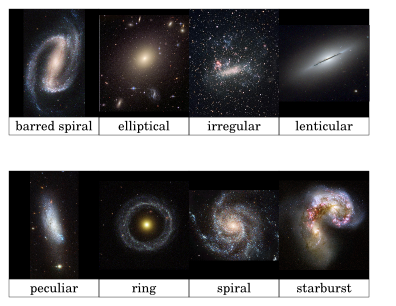
What would we expect the curve to look like based on the first observation? Well, try giving it some thought, then click the image to find out if you were right. The image below represents the observed rotation curve. Astronomers have determined that nearly all of the luminous material is within 15 kpc (about 50,000 light years) from the galactic center. We can use our very own Milky Way as an example. Elliptical galaxies range in size from giants, more massive than any spiral, down to dwarfs, with masses of only about 10 6 M Sun. Our own Galaxy and the Andromeda galaxy are typical, large spiral galaxies (see. When comparing the two mass estimates, however, they are vastly different. Many smaller galaxies, in contrast, have an irregular shape. We can determine the period and semi-major axis by measuring how far away the galaxy is and its rotation speed via the doppler shift. It's the same way astronomers measured the mass of the Sun! Newton's derivation of Kepler's third law relates the orbital period \(T\), the semi-major axis \(a\), and the enclosed mass \(M\) via There is another more sure-proof method for measuring galaxy masses. Thus by measuring the luminosity of the galaxy we can get a mass estimate and then divide by the average stellar mass. For stars on the Main Sequence, the luminosity is related to the mass via \(L \propto M^\). Another similar method involves using a mass-to-light ratio. How do we measure the number of stars in a galaxy when we can't resolve them? This is done by measuring the luminosity of the galaxy and dividing by the average luminosity of a star. The largest known galaxy in the universe (IC 1101) has an estimated 100 trillion stars! While this might seem like a lot of stars, it turns out our galaxy isn't all that big. A classification based on their optical appearance or morphology. Each dot represents a star in our galaxy. Hubble quickly realized that the vast majority of galaxies have only a small number of shapes.

To get an idea of how many stars this is, look at the GAIA 3D Star Map. Though it is possible to see trends in the general shapes. This figure shows Edwin Hubble’s original classification of galaxies. Figure 26.6 Hubble Classification of Galaxies. Photographs of spiral galaxies, illustrating the different types, are shown in Figure 26.6, along with elliptical galaxies for comparison. Elliptical galaxies are spheroidal in shape and their stars wrap around the galaxy core equally in all directions. Our Galaxy and the Andromeda galaxy are both intermediate between the two extremes. Spiral galaxies have a twisting swirl shape and often have younger, bluer stars. Many follow broad classification patterns, but no two are exactly alike. In 1936, Hubble debuted a way to classify galaxies, grouping them into four main types: spiral galaxies, lenticular galaxies, elliptical galaxies, and irregular galaxies. The 3 most common types of galaxies are classified by their shape, and they include spiral, elliptical, and irregular galaxies. Our Milky Way galaxy contains over 100 billion stars. With long exposures on film, various features such as spiral structure and star clusters are visible. Scientists now estimate that there are over a trillion galaxies in the Universe.


 0 kommentar(er)
0 kommentar(er)
